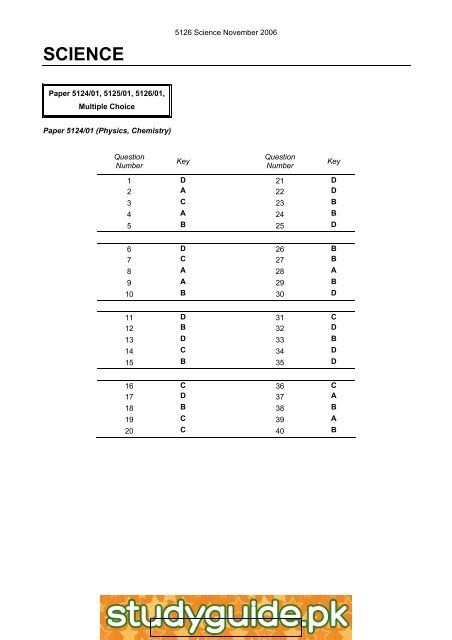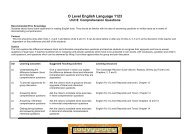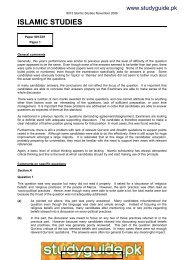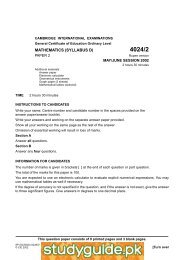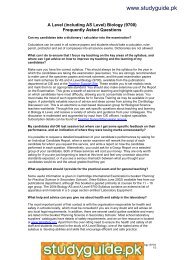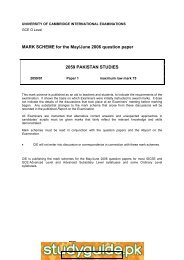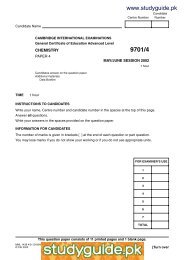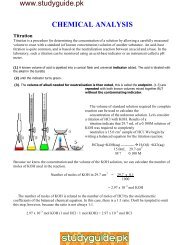SCIENCE www.xtremepapers.net - notes
SCIENCE www.xtremepapers.net - notes
SCIENCE www.xtremepapers.net - notes
You also want an ePaper? Increase the reach of your titles
YUMPU automatically turns print PDFs into web optimized ePapers that Google loves.
<strong>SCIENCE</strong><br />
5126 Science November 2006<br />
Paper 5124/01, 5125/01, 5126/01,<br />
Multiple Choice<br />
Paper 5124/01 (Physics, Chemistry)<br />
Question<br />
Number<br />
Key<br />
Question<br />
Number<br />
Key<br />
1 D 21 D<br />
2 A 22 D<br />
3 C 23 B<br />
4 A 24 B<br />
5 B 25 D<br />
6 D 26 B<br />
7 C 27 B<br />
8 A 28 A<br />
9 A 29 B<br />
10 B 30 D<br />
11 D 31 C<br />
12 B 32 D<br />
13 D 33 B<br />
14 C 34 D<br />
15 B 35 D<br />
16 C 36 C<br />
17 D 37 A<br />
18 B 38 B<br />
19 C 39 A<br />
20 C 40 B<br />
1<br />
<strong>www</strong>.<strong>xtremepapers</strong>.<strong>net</strong>
5126 Science November 2006<br />
Paper 5125/01 (Physics, Biology)<br />
Question<br />
Number<br />
Paper 5126/01 (Chemistry, Biology)<br />
Key<br />
Question<br />
Number<br />
Key<br />
1 D 21 A<br />
2 A 22 A<br />
3 C 23 C<br />
4 A 24 A<br />
5 B 25 B<br />
6 D 26 A<br />
7 C 27 C<br />
8 A 28 D<br />
9 A 29 A<br />
10 B 30 A<br />
11 D 31 D<br />
12 B 32 A<br />
13 D 33 B<br />
14 C 34 A<br />
15 B 35 D<br />
16 C 36 B<br />
17 D 37 A<br />
18 B 38 B<br />
19 C 39 C<br />
20 C 40 B<br />
Question<br />
Number<br />
Key<br />
Question<br />
Number<br />
Key<br />
1 D 21 A<br />
2 D 22 A<br />
3 B 23 C<br />
4 B 24 A<br />
5 D 25 B<br />
6 B 26 A<br />
7 B 27 C<br />
8 A 28 D<br />
9 B 29 A<br />
10 D 30 A<br />
11 C 31 D<br />
12 D 32 A<br />
13 B 33 B<br />
14 D 34 A<br />
15 D 35 D<br />
2<br />
<strong>www</strong>.<strong>xtremepapers</strong>.<strong>net</strong>
5126 Science November 2006<br />
16 C 36 B<br />
17 A 37 A<br />
18 B 38 B<br />
19 A 39 C<br />
20 B 40 B<br />
General comments<br />
The paper produced a mean score of 20.32 and a standard deviation of 6.61. Candidates found, papers<br />
5124 and 5125 Questions 7, 14 and 15 very easy with Questions 2 and 5 very difficult. Guessing from<br />
among some better candidates was evident from a number of the other questions.<br />
Physics, Paper 5124/5125/01 – Questions 1 to 20<br />
Question 1 was answered correctly by 73% of the candidates. Options A and C attracted, in equal<br />
numbers, most of the remaining candidates.<br />
Question 2<br />
Very difficult with only 3% answering correctly! In choosing option B, the majority of candidates either<br />
ignored or failed to appreciate the significance of a curved speed-time graph. A number of more able<br />
candidates chose option C.<br />
Question 3 discriminated well with the more able candidates choosing correctly (option C) and the majority<br />
of the weaker candidates, ignoring the time periods at rest, the incorrect option, A.<br />
Question 4<br />
Excellent discrimination with candidates choosing either option A (correct) or option D.<br />
Question 5<br />
The majority of candidates failed to consider fully the information given in the responses. A possible correct<br />
combination of force and distance acting to the right of the pivot (option A) attracted more than twice the<br />
number of responses than did the correct response, option B. Ignoring the force direction, a significant<br />
number of more able candidates chose option D.<br />
Question 6<br />
Showed widespread guessing among candidates with option A attracting more responses than the correct<br />
option D and option C attracting almost as many as D.<br />
Question 7<br />
A surprisingly easy question although a number of more able candidates made the classical error of ignoring<br />
the force direction in choosing option A.<br />
Question 8 discriminated poorly with options A and B attracting the majority of candidates, both able and<br />
less able, in almost equal numbers.<br />
Question 9<br />
It is pleasing to note that the amplitude of a wave was known by most of the candidates.<br />
Question 10 showed excellent discrimination with option C attracting most of the weaker candidates<br />
3<br />
<strong>www</strong>.<strong>xtremepapers</strong>.<strong>net</strong>
5126 Science November 2006<br />
Question 11<br />
Good discrimination although some more able candidates chose option C.<br />
Question 12 also showed excellent discrimination with the less able candidates favouring option A slightly<br />
more than option D.<br />
Question 13<br />
The definition of potential difference was not well known with a significant number of more able candidates<br />
attracted to options A, in particular, and B.<br />
Question 14<br />
The determination of resistance from a V/I graph was well known.<br />
Question 15<br />
Potential difference in a series circuit was also well known although option A tempted a significant number of<br />
more able candidates.<br />
Question 16 showed widespread guessing among all the candidates.<br />
Question 17<br />
Good discrimination. The true test for a mag<strong>net</strong> still eludes the weaker candidates whose responses were<br />
evenly spread over the three incorrect options.<br />
Question 18<br />
Excellent discrimination with weaker candidates showing a slight bias for option C over option A.<br />
Question 19<br />
Nuclide notation was well known.<br />
Question 20 provided good discrimination. However the novel approach to half-life posed problems for less<br />
able candidates who were equally spread over the three incorrect options.<br />
Chemistry, Paper 5124/01 – Questions 21 to 40 and 5126/01 – Questions 1 to 20<br />
Question 21<br />
An easy question particularly for the better candidates.<br />
Question 22<br />
The arrangement and movement of molecules in ice was extremely well known.<br />
Question 23<br />
Another well answered question. The structure of atoms is well understood by the majority of the candidates<br />
Question 24<br />
Once again the majority of the candidates understood the properties of an ionic compound. A significant<br />
number of the candidates thought that sodium chloride did not conduct electricity when it is molten.<br />
Question 25<br />
Covalent bonding is not understood by the majority of the candidates. Over 50% of the candidates<br />
answered the question in terms of electron pairs and chose option B rather than total number of shared<br />
electrons as required by the question.<br />
4<br />
<strong>www</strong>.<strong>xtremepapers</strong>.<strong>net</strong>
5126 Science November 2006<br />
Question 26<br />
The calculation of the mass of carbon dioxide proved easy for the better candidates. The weaker candidates<br />
simply calculated the M r of carbon dioxide and chose option D.<br />
Question 27<br />
This question proved difficult for the majority of the candidates. Many of the candidates, particularly the<br />
weaker candidates, chose option D which is the correct answer for an exothermic reaction. The better<br />
candidates recognised that the temperature of the water decreases during an endothermic reaction.<br />
Question 28<br />
This question proved difficult for even the better candidates. Less than half of the candidates recognised<br />
that the mass of zinc is doubled in the second experiment and therefore the volume of hydrogen produced<br />
also doubles because the hydrochloric acid is in excess in both experiments.<br />
Question 29<br />
An easy question for the majority of the candidates.<br />
Question 30<br />
The trends in the elements in Group I of the Periodic Table are well known by the majority of the candidates,<br />
however a significant number of candidates thought that the elements become less metallic as the Group is<br />
descended.<br />
Question 31<br />
The majority of the candidates were able to interpret the experimental results and correctly deduce the order<br />
of reactivity of the metals. A significant number of candidate chose option B where the metals were listed<br />
with the least reactive first.<br />
Question 32<br />
The majority of the better candidates know that magnesium is used to prevent rusting by sacrificial protection<br />
however there was evidence of guesswork amongst the weaker candidates.<br />
Question 33<br />
The better candidates found this question easy. Many of the weaker candidates answered the question in<br />
terms of properties which are important for the use of aluminium for cooking utensils<br />
Question 34<br />
This question was poorly answered by the majority of the candidates. The majority of the candidates chose<br />
option A, thinking that methane is responsible for the depletion of the ozone layer rather than global<br />
warming.<br />
Question 35<br />
The better candidates know that the main constituent of natural gas is methane but the majority of the<br />
candidates thought that the gas is hydrogen.<br />
Question 36<br />
Another easy question particularly for the better candidates. Many of the weaker candidates chose option B,<br />
the molecular formula of an alkene rather than an alkane.<br />
5<br />
<strong>www</strong>.<strong>xtremepapers</strong>.<strong>net</strong>
5126 Science November 2006<br />
Question 37<br />
The majority of the candidates recognised the process as cracking although dehydrogenation and<br />
polymerisation were popular distracters amongst the weaker candidates.<br />
Question 38<br />
The majority of the candidates recognised the hydrocarbon as an alkene and were able to correctly identify<br />
the correct test for an alkene.<br />
Question 39<br />
This question proved difficult for many candidates. The most popular response was option D, propanoic acid<br />
and was given by significant proportion of the better candidates. Candidates should know that oxidation of<br />
ethanol does not increase the number of carbon atoms in the chain.<br />
Question 40<br />
The better candidates were able to identify the linkage as an amide link and knew that nylon contains this<br />
link. There was evidence of guesswork amongst the weaker candidates.<br />
Biology, Paper 5125/5126/01 – Questions 21 to 40<br />
Question 21<br />
This relatively easy question was correctly answered by most candidates.<br />
Question 22<br />
This question caused problems. Candidates needed to recognise the role of the cell membrane in controlling<br />
water uptake.<br />
Question 23<br />
Most candidates understood that osmosis always involves water movement.<br />
Question 24<br />
Answer C was a popular choice here: many candidates apparently think that the optimum pH for an enzyme<br />
is always 7.<br />
Question 25<br />
Candidates had difficulty in interpreting this experiment, and they were apparently guessing.<br />
Question 26 and Question 27<br />
Few candidates understood the role of nitrate ions (in plants) or of extra food energy for cold conditions (in<br />
animals).<br />
Question 28<br />
Candidates needed to understand the difference between absorption and assimilation; and to recognise the<br />
role of the liver, in secreting bile to aid digestion.<br />
Question 29 and Question 30<br />
These were easy questions.<br />
6<br />
<strong>www</strong>.<strong>xtremepapers</strong>.<strong>net</strong>
5126 Science November 2006<br />
Question 31<br />
Only a minority of candidates realised that the carbon dioxide concentration is highest in blood entering the<br />
lungs.<br />
Question 32<br />
This simple question proved surprisingly difficult. Carbon dioxide is not produced by anaerobic respiration in<br />
animals.<br />
Question 33<br />
Many candidates were apparently guessing here.<br />
Question 34<br />
This question was one of simple factual recall.<br />
Question 35<br />
This question was very easy.<br />
Question 36<br />
Significant numbers of candidates think that plant respiration uses up carbon dioxide.<br />
Question 37<br />
Even the better candidates had difficulty in linking sulphur dioxide pollution to acid rain and the acidification<br />
of rivers.<br />
Question 38<br />
Many candidates failed to realise that the outcome of plant sexual reproduction (from seeds) is<br />
unpredictable.<br />
Question 39<br />
Option A (that egg cells contain a Y chromosome) was a surprisingly popular wrong answer here.<br />
Question 40<br />
This question caused problems, even for some of the better candidates. They needed to recognise that<br />
continuous variation is along a range, and is therefore without distinct types.<br />
7<br />
<strong>www</strong>.<strong>xtremepapers</strong>.<strong>net</strong>
<strong>SCIENCE</strong><br />
5126 Science November 2006<br />
Paper 5126/03<br />
Chemistry<br />
General comments<br />
Section A<br />
1. (a) Well answered, though a significant number of candidates gave ‘hydrogen’ as a component of<br />
clean, dry air.<br />
(b)<br />
Both a pollutant and the means whereby it entered the atmosphere were needed for these three<br />
marks to be earned<br />
2. (a) ‘Fractional distillation’ was not accepted as a correct description of this process. ‘Condensing’ was<br />
the change taking place in the condenser though a description such as ‘changing steam/water<br />
vapour to water’ was accepted for full marks<br />
(b)<br />
(c)<br />
A unit was expected when giving the temperature of boiling water.<br />
Most candidates realised that the impurity, salt in this instance, remained in the flask and was not<br />
somehow trapped by the condenser.<br />
3. (a) While ‘-CH 2 .CH 2 -’ is considered to be the correct repeating unit in this structure, ‘[-CH 2 .CH 2 -] n ’ was<br />
also accepted for the full mark. A double bond drawn within the repeating unit caused the mark to<br />
be lost. ‘Nylon’ is the commonly accepted name for this structure, see syllabus, but the term<br />
‘polyamide’ was also considered acceptable. Nylon is used in very many ways and this was<br />
reflected in the responses of candidates.<br />
(b)<br />
Responses that described a property of these polymers and a property of iron and steel was<br />
needed to explain why, when carelessly disposed of, objects made of plastics are a longer-term<br />
problem than objects made of iron and steel. ‘Plastics are non-biodegradable while iron and steel<br />
rust away’ was sufficient.<br />
4. (a) Balancing of the given equation was generally well accomplished.<br />
(b)<br />
(c)<br />
(d)<br />
(e)<br />
Relative molecular mass usually correctly calculated<br />
Most candidates found this fairly elementary calculation difficult. Many made no attempt to base<br />
their calculations upon the chemical equation previously balanced.<br />
Just using litmus paper was accepted as being a sufficient test to show that all acid had been<br />
removed.<br />
Few candidates realised that an advantage of using slaked lime to neutralise sulphuric acid the<br />
product, described in the question as being insoluble, is that it cannot be washed in solution into<br />
rivers and drains and so cause pollution.<br />
5. Well answered.<br />
(a)<br />
Most candidates could identify halogens and alkali metals from the Periodic Table provided.<br />
(b/c) Both tested the ability of candidates to use the Periodic Table’s trends, both physical and chemical.<br />
(d)<br />
As the chemicals chosen for this question were not necessarily common, candidates were required<br />
to determine, rather than remember, the formula of two chemical compounds.<br />
8<br />
<strong>www</strong>.<strong>xtremepapers</strong>.<strong>net</strong>
5126 Science November 2006<br />
6. (a) While a fairly wide range of response was accepted for the estimated boiling point of pentan-1-ol<br />
only the response ‘88’ was accepted for its molecular mass.<br />
(b)<br />
(c)<br />
All bonds had to be shown in drawing the structural formula of ethanol, including ‘O-H’.<br />
Many candidates realised that, in excess oxygen, ethanol will burn to form only carbon dioxide and<br />
water.<br />
7. (a) Candidates found it relatively easy to identify the correct order of reactivity of the four elements in a<br />
table of reactions as C, D, B, A.<br />
(b/c) Few of the metals listed in this syllabus will not react with either cold water or dilute hydrochloric<br />
acid. Identification of C, probably copper, as being the least reactive of these metals and so the<br />
easiest to extract from its naturally occurring ore was not well completed.<br />
8. (a) Many candidates could interpret these graphs as showing that the reaction was initially fast, then<br />
less fast and eventually at a halt. However, several candidates decided that point ‘E’ on the graph<br />
indicated that the rate of the decomposition was increasing when in fact it wa decreasing.<br />
Candidates who identified the rate as being constant at point G did not earn the mark available for<br />
‘the decomposition has stopped’.<br />
(b)<br />
That the rate of reaction in this particular volume of solution depends upon the number of<br />
molecules of hydrogen peroxide present, i.e. more molecules give a faster reaction, was well<br />
understood. Usually, though this need not have been specified in this case, it is the concentration<br />
of molecules/ions that determines the rate of the reaction.<br />
Section B<br />
9. (a) (i) Ammonia, carbon dioxide, calcium carbonate and silver chloride were the substances that had<br />
to be identified. Calcium carbonate and silver chloride were commonly identified correctly.<br />
(ii) Candidates had to realise that, when testing for a chloride ion, hydrochloric acid should not be<br />
added during the investigation as it itself contains chloride ions.<br />
(b)<br />
(c)<br />
The mixture ‘H’ contained both a nitrate and a carbonate/hydrogen carbonate<br />
Several candidates chose to give chemical equations for reactions that were not part of the<br />
description and so failed to earn these two marks.<br />
10. (a) For some unknown reason ammonia (it had been an answer to part of the previous question) was<br />
often given as an example of a gaseous mixture. While ‘air’ was the expected response, ‘natural<br />
gas’ and ‘car exhaust fumes’ were also acceptable. Such mixtures as hydrochloric acid were often<br />
given, incorrectly, as examples of a liquid compound. ‘Water’ was the expected response, though<br />
occasionally ethanol and ethanoic acid were given and accepted.<br />
(b)<br />
The differences between the movement of particles within solids, liquids and gases was well<br />
described. ‘The molecules have moved further apart’ was accepted when describing a liquid.<br />
11. (a/b) Any ore of iron was given the mark available. A good knowledge was shown of the chemistry that<br />
goes on within a blast furnace. Many correct chemical equations were included: at least two were<br />
needed for full marks to be awarded.<br />
(c)<br />
Either steel or brass was usually specified as an example of an alloy. While there are many<br />
different steels, iron and carbon had to be included in listing the components of a steel.<br />
9<br />
<strong>www</strong>.<strong>xtremepapers</strong>.<strong>net</strong>
5126 Science November 2006<br />
<strong>SCIENCE</strong> (CHEMISTRY, BIOLOGY)<br />
Paper 5126/04<br />
Theory (Biology)<br />
General comments<br />
In general the performance of candidates on this paper was very disappointing. Few managed to score<br />
more than ten marks. For the majority knowledge of the syllabus was sparse, with most candidates showing<br />
little grasp of key concepts involved. In addition, most candidates showed a very poor ability to use or<br />
interpret information provided in the question. For the majority of candidates the few marks they obtained<br />
came from simple recall. It was clear that many failed to understand what was being asked for in many of<br />
the questions, giving answers with little or no relevance. Many answers simply repeated part of the question.<br />
A few candidates showed some familiarity with one or two parts of the syllabus, but no candidate showed<br />
knowledge and understanding across the whole syllabus. Although performance in Section A was poor, that<br />
in Section B was even worse. Given the freedom to frame answers themselves, most candidates wrote<br />
vague and irrelevant attempts that gained no credit. Many candidates scored no marks at all in Section B.<br />
As in previous years a few candidates attempted only one Section B question, though there was no<br />
evidence that this resulted from a lack of time.<br />
Comments on specific questions<br />
Section A<br />
Question 1<br />
This question was answered well by almost all candidates. The simple recall required in (a)(i) and (b)(i)<br />
earned many candidates full marks for these sections. A lack of ability to use information to frame answers<br />
lost most, or all, of the other marks in this question for the majority of candidates. For many candidates this<br />
question gained almost all of their marks for the paper.<br />
(a) (i)<br />
(ii)<br />
(b) (i)<br />
(ii)<br />
Most candidates gained two or three marks from this question. The most common errors were<br />
chloroplast for A and cell wall for C.<br />
Only the more able candidates mentioned control of entry of substances. Many wrote incorrect<br />
answers based on entry of water by osmosis or protection of cell contents.<br />
Most candidates had learned the syllabus definition of osmosis and gained three marks. Many<br />
weaker candidates omitted to mention either water of the semi-permeable membrane.<br />
Very few candidates mentioned surface area. Most simply wrote about osmosis, gaining no credit.<br />
Question 2<br />
Only the more able candidate showed a good knowledge of this area of the syllabus. Many candidates<br />
scored no marks for this question.<br />
(a) (i)<br />
(ii)<br />
Only the most able candidates could correctly define the term hormone. Many candidates wrote<br />
incorrect answers based on gastric juice and actions in the stomach.<br />
Difference in the speed and/or length of action of nerves and hormones was mentioned by only a<br />
tiny number of candidates. Most had little idea of what the question asked.<br />
(iii) Very few candidates showed any knowledge of reflex action. The majority wrote irrelevant<br />
sentences containing the words given in the question. A few candidates re-ordered the words with<br />
no further explanation.<br />
10<br />
<strong>www</strong>.<strong>xtremepapers</strong>.<strong>net</strong>
5126 Science November 2006<br />
(b) (i)<br />
(ii)<br />
A few of the more able candidates knew that digestion breaks larger molecules into smaller ones.<br />
Incorrect answers commonly included details of food requirements or reference to enzymes.<br />
More able candidates knew that amylase converts starch to maltose. Common incorrect answers<br />
referred to proteins or to conditions required for enzyme action.<br />
Question 3<br />
Most candidates showed a complete lack of the ability to interpret the information given to them in this<br />
question. Many had great difficulty in understanding the requirements of the questions.<br />
(a)<br />
(b) (i)<br />
(ii)<br />
Whilst a few candidates realised that both frequency and depth of breathing increase, most had<br />
little idea of what was required in the answers. Many quoted numbers from the table.<br />
The correct answer, 30 x 4.2 = 126 dm 3 /min, was never seen. Many candidates multiplied 8.0 by<br />
12, or gave a meaningless jumble of figures.<br />
Most answers were long and vague, with mention of the need for oxygen during exercise but no<br />
attempt to answer the question. Mention of respiration was seldom seen.<br />
Question 4<br />
Again the majority of candidates could not interpret the information given to form the basis for their answers.<br />
Most scored no marks for this question.<br />
(a)<br />
(b)<br />
(c)<br />
(d)<br />
Very few candidates realised that water shrimp require a high concentration of dissolved oxygen to<br />
live, although this information was provided in the stem. Most wrote vague answers about dirty<br />
water. No candidate mentioned the bacteria that feed on materials in sewage. or the effect that<br />
these bacteria have on the oxygen content of the water.<br />
A few candidates realised that the oxygen content increased with distance from the sewage outlet<br />
pipe, gaining one mark. Most wrote vague answers about the water being less polluted or further<br />
away from the pipe.<br />
No candidates suggested that this was a control or for comparison. Many referred to this part of<br />
the river having no pollution, gaining no credit. Others simply mentioned that this was where the<br />
scientist could find fresh water shrimp.<br />
Few candidates made sensible suggestions. Common incorrect answers referred to rubbish<br />
thrown into the river or made vague reference to pollution from factories.<br />
Question 5<br />
Most candidates gained some marks from this question, usually from (a)(i) and (b). Though most knew how<br />
to construct a diagram to work out the inheritance of recessive and dominant alleles, few had a clear<br />
understanding of the process.<br />
(a) (i)<br />
(ii)<br />
(b)<br />
(c)<br />
Most candidates gained this mark, with nn being the most popular answer.<br />
Most candidates wrote vague answers that gained no credit. Many referred to the alleles of<br />
parents but none mentioned inheritance of the recessive allele from both parents. Many thought<br />
that the lack of night blindness was simply inherited from the mother.<br />
Most candidates could construct a suitable diagram to work out the genotypes of the offspring,<br />
gaining three marks. Few managed to infer the chance of night blindness from their diagram.<br />
Some of the weaker candidates used incorrect parent genotypes, despite these being given in the<br />
question. These candidates usually gained some marks on an ‘error carried forward’ basis.<br />
No candidates showed knowledge of sex determination as a results of the combination of X and Y<br />
chromosomes. Most gave vague answers referring to inheritance of gender being determined by<br />
the father, gaining no credit.<br />
11<br />
<strong>www</strong>.<strong>xtremepapers</strong>.<strong>net</strong>
5126 Science November 2006<br />
Section B<br />
Question 6<br />
Whilst some candidates gained a few marks from this question, most wrote vague and rambling answers that<br />
gained little or no credit. Many scored zero marks.<br />
(a)<br />
(b)<br />
Only a few candidates knew that HIV is the virus that, after infection, can lead to the symptoms<br />
associated with AIDS. Many thought that they were two different diseases that spread in different<br />
ways. Many candidates gained a mark for mention that HIV is spread amongst addicts by sharing<br />
of needles, but the significance of blood transfer was never seen. Fewer could explain how alcohol<br />
increases promiscuity and therefore increases the spread of HIV by sexual contact.<br />
Most candidates based their answers on draconian measures they thought should be taken against<br />
drug dealers and users, gaining no credit. Only the most able made sensible suggestions based<br />
on education or use of the media to spread knowledge. Ideas of issuing free condoms or sterile<br />
needs were not seen. Some candidates made sensible comments about the problems in<br />
developing countries, including the effects of a lack of resources and poor communications.<br />
However, most simply described the extent of the problem rather than referring to control or<br />
treatment.<br />
Question 7<br />
No candidate showed a good knowledge and understanding of the carbon cycle. Some candidates<br />
managed to score a few marks, but many failed to score any.<br />
(a)<br />
(b)<br />
Very few candidates had any clear ideas of what the carbon cycle is. Many tried to draw a<br />
diagram, but almost all had no reference to carbon dioxide in the air. In most diagrams the terms<br />
were placed and/or joined in an illogical manner. A large number of candidates simply wrote a<br />
sentence about each term, with no reference to the carbon cycle at all.<br />
Some candidates gained a mark or two by referring to deforestation and its effect on the removal of<br />
carbon dioxide from the air. Few candidates gave a coherent enough explanation of the<br />
combustion of fossil fuels and consequent release of carbon dioxide to be worth any marks. A<br />
small number of candidates scored marks by a correct reference to global warming and its effects.<br />
Many made incorrect reference to the ozone layer or to the effect of using greenhouses.<br />
Question 8<br />
This question was a disaster for most candidates. Knowledge of the carbon cycle was generally poor, and<br />
the ability to frame an answer to the question asked was shown by only the most able. Few candidates<br />
scored more than one mark, and many did not score.<br />
(a)<br />
(b)<br />
Most candidates simply repeated the information provided in the question. Many showed<br />
considerable confusion as to from where the plant gains each component for photosynthesis. Only<br />
the most able mentioned stomata, and none mentioned xylem. The only mark gained by a<br />
significant number of candidates was for the idea of energy being obtained from sunlight. There<br />
was similar confusion about the fate of the products of photosynthesis, with only the most able<br />
making sensible suggestions involving release of oxygen through stomata and conversion of<br />
glucose to starch.<br />
Most candidates misunderstood this question, not realising that they were required to write about<br />
an experiment they could perform. None of the few who did realise that this is what the question<br />
was asking managed to put together a sensible suggestion. No candidate mentioned use of a<br />
plant such as elodea, a means of varying light intensity, e.g. distance from a lamp, or a method to<br />
measure the rate of photosynthesis e.g. counting oxygen bubbles. Most candidates scored zero.<br />
12<br />
<strong>www</strong>.<strong>xtremepapers</strong>.<strong>net</strong>


